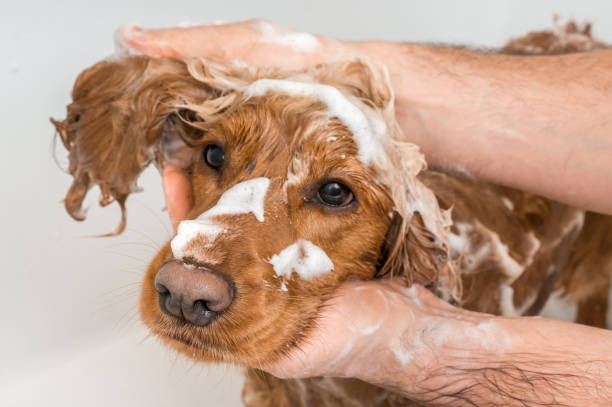Last Updated on January 23, 2024 by Fumipets
Unveiling the Canine Spa Routine: How Often Should You Wash Your Dog?
Dogs, our loyal companions, come with their own set of grooming needs to keep them happy and healthy. Among the essential aspects of dog care is bathing, a practice that not only keeps your furry friend smelling fresh but also contributes to their overall well-being.
However, the frequency of dog baths can vary based on factors such as breed, lifestyle, and individual health conditions. In this exploration, we embark on the journey to understand the ideal bathing routine for our canine companions.
How Often Should You Wash Your Dog?
A clean dog is a healthy dog. However, finding out how often a dog should be bathed can be challenging for the newly inducted dog parent. Other tricky parts can include how to go about brushing a dog with short hair, as one with a different type of hair may call for a different grooming routine.
But we’re here to help you with the “washing” part at least. When you get your pet’s bathing schedule right, you help keep his skin and hair smooth and healthy.
Is Dog Bathing for You or Your Dog?
It’s for both, though we understand how it may look like baths are more for the dog owner’s benefit than for the dog. Some dogs just can’t wait to get it over with, and others might not even want to start.
Nevertheless, bathing your dog every two or three months should generally be acceptable to both parties. It should also provide you the opportunity to look for signs of skin abnormalities or lumps that could suggest a health problem. After all, we never want our pets to get sick.
With that, let’s now discuss how to structure the right bathing schedule for your furry friend.

How to Structure Your Dog’s Grooming
Giving your dog a bath based on a routine bathing schedule may be more beneficial, but you still need to determine whether or not to go for “more” baths or “fewer” baths. There is no universal recommendation for how often you should give your dog a bath, as this would be dependent on various factors.
Despite the absence of a general rule for dog washing, a good routine generally revolves around the following:
Lifestyle
Dogs have different lifestyles compared to humans. Certainly, someone (an animal, in this case) prone to playing in the mud will need a completely different bathing routine compared to someone (that’s us, humans!) who tries to stay clean as much as possible. Lifestyle also varies from one canine to another, so it’s important to evaluate your pet’s lifestyle before deciding his washing schedule.
Then, there’s your lifestyle to take into consideration. Assess how your dog goes about his daily routine, and you should have a relatively solid basis for structuring your pet’s washing schedule.
Coat Types
After a stroll in the park or on the trails, dogs with shorter coats can typically get by with a moist towel. If you allow your dog to swim at the beach, play in mud puddles, or interact with other pups, you may need to bathe him more frequently to ensure no dirt and debris is left on his coat.
We know it’s unrealistic to expect your dog to be completely clean, but it’s crucial to ensure that he’s not dirty enough to smell or get sick. You have to draw a clear line regarding hygiene and cleanliness.
The recommended bathing schedule for dogs with medium to long coats is every four to six weeks. On the other hand, dogs with short coats may be washed once, twice, or thrice a month. Short coats don’t accumulate as much dirt and can be washed less frequently.
Looking further into coat type, it is important to know that texture, more than length, is a more determining element in your dog’s bathing routine.
For example, Poodles generally have softer coats, making them particularly susceptible to dirt particles. A Yorkshire terrier is another breed with a coat that enjoys gathering dirt. These dogs require frequent bathing to retain a fresh scent and shiny coat.
Although bathing is recommended once a month on average, some breeds require weekly bathing. These canines are hairless or have oily coats, such as Labrador retrievers. Bathing once a week can help protect their skin from germs and other pollutants.
Dogs with lengthier fur normally shed these contaminants, but those with greasy or hairless coats need a little extra aid. Maintaining a weekly bathing program for hairless dogs, such as the hairless Rat Terriers, can assist in preventing dermatological concerns.
Skin Conditions
Your dog’s skin is another crucial factor when deciding how often to bathe him. Other dogs have skin problems or a brief skin illness that necessitates the regular use of a particular shampoo recommended by a veterinarian.
Your dog may acquire a transient skin issue requiring strict attention to his washing schedule. If your vet has recommended a particular shampoo, you may have to wash your dog with it more frequently than usual.

Breed
Since there are so many dog breeds with various hair types, it’s a good idea to seek grooming advice from your veterinarian, particularly for breeds that require a lot of grooming. You want to consult about how much bathing your dog needs and what products to use.
Hairless breeds, such as the Powderpuff, require weekly baths and are expensive to maintain. Brushing is needed more than bathing in certain breeds. Shetland sheepdogs, for example, have double-coated, thick-shedding hair that requires combing and brushing before, during, and after soaking and moisturizing baths.
There you have it! Four factors to structure your dog’s bathing schedule around. Align your dog’s washing routine with all four, and it should benefit both you and your canine companion in the long run.
Q&A: Decoding the Doggy Bathing Dilemma
How often should you bathe your dog, and does it vary by breed?
The frequency of dog baths is influenced by factors like breed, coat type, and activities. Generally, dogs with short coats and minimal outdoor exposure may require bathing every 2-3 months. Breeds with longer hair or those prone to skin issues might benefit from more frequent baths, ranging from every 2-4 weeks.
Can bathing your dog too frequently be harmful?
Yes, bathing your dog excessively can strip their skin of natural oils, leading to dryness and irritation. For most dogs, a bath every 4-6 weeks is sufficient. However, dogs with specific skin conditions or medical needs may require more frequent baths as recommended by veterinarians.
What signs indicate that your dog needs a bath?
Watch for signs such as a noticeable odor, visible dirt, or changes in coat texture. Scratching or licking excessively may also signal skin issues that could be alleviated with a bath. Observing your dog’s behavior and coat condition helps determine when it’s time for a refreshing bath.
How can you make the bathing experience enjoyable for your dog?
Turn bath time into a positive experience by using treats, gentle praise, and calming reassurance. Gradually introduce your dog to the bathing process, starting with simple water exposure and working up to a full bath. Using dog-friendly shampoos and maintaining a calm environment can also contribute to a more enjoyable experience.
Are there breed-specific considerations for dog bathing routines?
Yes, different dog breeds have unique grooming needs. Breeds with water-resistant coats, like Retrievers, may not need frequent baths, while those with hair instead of fur, such as Poodles, may require more regular grooming. Understanding your dog’s breed-specific requirements is crucial for tailoring an effective and beneficial bathing routine.


















